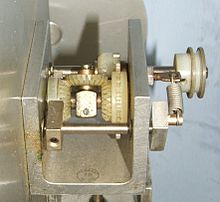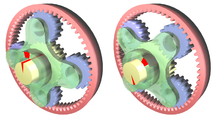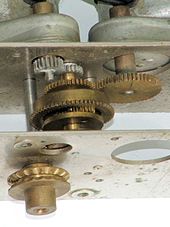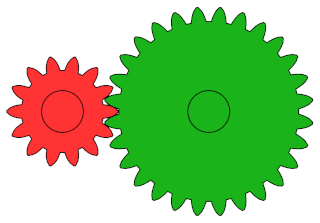
A gear is a rotating circular machine part having cut teeth or, in the case of a cogwheel or gearwheel, inserted teeth, which mesh with another (compatible) toothed part to transmit rotational power. While doing so, they can change the torque and rotational speed being transmitted and also change the rotational axis of the power being transmitted. The teeth on the two meshing gears all have the same shape.

An axle or axletree is a central shaft for a rotating wheel or gear. On wheeled vehicles, the axle may be fixed to the wheels, rotating with them, or fixed to the vehicle, with the wheels rotating around the axle. In the former case, bearings or bushings are provided at the mounting points where the axle is supported. In the latter case, a bearing or bushing sits inside a central hole in the wheel to allow the wheel or gear to rotate around the axle. Sometimes, especially on bicycles, the latter type of axle is referred to as a spindle.
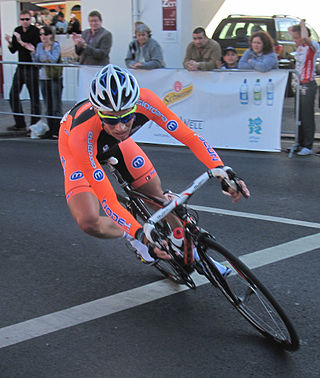
Steering is the control of the direction of locomotion or the components that enable its control. Steering is achieved through various arrangements, among them ailerons for airplanes, rudders for boats, tilting rotors for helicopters, and many more.

An epicyclic gear train is a gear reduction assembly consisting of two gears mounted so that the center of one gear revolves around the center of the other. A carrier connects the centers of the two gears and rotates, to carry the planet gear(s) around the sun gear. The planet and sun gears mesh so that their pitch circles roll without slip. If the sun gear is held fixed, then a point on the pitch circle of the planet gear traces an epicycloid curve.

A four-wheel drive, also called 4×4 or 4WD, is a two-axled vehicle drivetrain capable of providing torque to all of its wheels simultaneously. It may be full-time or on-demand, and is typically linked via a transfer case providing an additional output drive shaft and, in many instances, additional gear ranges.

A limited-slip differential (LSD) is a type of differential gear train that allows its two output shafts to rotate at different speeds but limits the maximum difference between the two shafts. Limited-slip differentials are often known by the generic trademark Positraction, a brand name owned by General Motors and originally used for its Chevrolet branded vehicles.
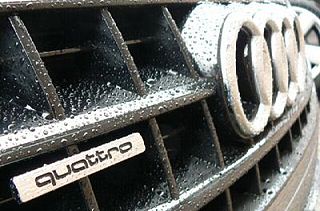
Quattro is the trademark used by the automotive brand Audi to indicate that all-wheel drive (AWD) technologies or systems are used on specific models of its automobiles.

In automotive design, a front-engine, front-wheel-drive (FWD) layout, or FF layout, places both the internal combustion engine and driven roadwheels at the front of the vehicle.
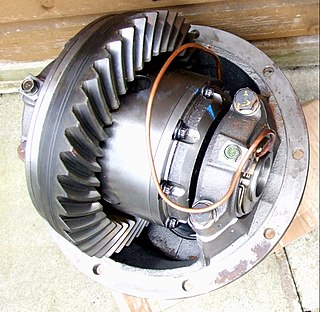
A locking differential is a mechanical component, commonly used in vehicles, designed to overcome the chief limitation of a standard open differential by essentially "locking" both wheels on an axle together as if on a common shaft. This forces both wheels to turn in unison, regardless of the traction available to either wheel individually.

A drive shaft, driveshaft, driving shaft, tailshaft, propeller shaft, or Cardan shaft is a component for transmitting mechanical power, torque, and rotation, usually used to connect other components of a drivetrain that cannot be connected directly because of distance or the need to allow for relative movement between them.

A portal axle is an off-road vehicle suspension and drive technology where the axle tube or the half-shaft is offset from – usually above – the center of the wheel hub and where driving power is transferred to each wheel via a simple gearbox, built onto each hub. It gives two advantages: ground clearance is increased, particularly beneath the low-slung differential housing of the main axles — and secondly, any hub reduction gearing allows the axle half shafts to drive the same power but at reduced torque. This reduces load on the axle crown wheel and differential.

A gear train or gear set is a machine element of a mechanical system formed by mounting two or more gears on a frame such that the teeth of the gears engage.

A worm drive is a gear arrangement in which a worm meshes with a worm wheel. The two elements are also called the worm screw and worm gear. The terminology is often confused by imprecise use of the term worm gear to refer to the worm, the worm wheel, or the worm drive as a unit.
ControlTrac four-wheel drive is the brand name of a selectable automatic full-time four-wheel drive system offered by Ford Motor Company. The four-wheel drive system was designed and developed at BorgWarner under its TorqTransfer Systems division in the mid 1980s. BorgWarner calls the system Torque-On-Demand (TOD). ControlTrac was the first automatic system to use software control and no planetary or bevel geared center differential. Instead of a planetary or bevel geared center differential, the system uses a variable intelligent locking center multi-disc differential.

Differential steering is the means of steering a land vehicle by applying more drive torque to one side of the vehicle than the other. Differential steering is the primary means of steering tracked vehicles, such as tanks and bulldozers, is also used in certain wheeled vehicles commonly known as skid-steer, and even implemented in some automobiles, where it is called torque vectoring, to augment steering by changing wheel direction relative to the vehicle. Differential steering is distinct from torque steer, which is usually considered a negative side effect of drive-train design choices.

A spiral bevel gear is a bevel gear with helical teeth. The main application of this is in a vehicle differential, where the direction of drive from the drive shaft must be turned 90 degrees to drive the wheels. The helical design produces less vibration and noise than conventional straight-cut or spur-cut gear with straight teeth.

In automotive design, an M4, or Mid-engine, Four-wheel-drive layout places the internal combustion engine in the middle of the vehicle, between both axles and drives all four road wheels.

A drivetrain or Transmission System, is the group of components that deliver mechanical power from the prime mover to the driven components. In automotive engineering, the drivetrain is the components of a motor vehicle that deliver power to the drive wheels. This excludes the engine or motor that generates the power. In marine applications, the drive shaft will drive a propeller, thruster, or waterjet rather than a drive axle, while the actual engine might be similar to an automotive engine. Other machinery, equipment and vehicles may also use a drivetrain to deliver power from the engine(s) to the driven components.

An H-drive drivetrain is a system used for heavy off-road vehicles with 6×6 or 8×8 drive to supply power to each wheel station.
This glossary of automotive terms is a list of definitions of terms and concepts related to automobiles, including their parts, operation, and manufacture, as well as automotive engineering, auto repair, and the automotive industry in general. For more specific terminology regarding the design and classification of various automobile styles, see Glossary of automotive design; for terms related to transportation by road, see Glossary of road transport terms; for competitive auto racing, see Glossary of motorsport terms.

